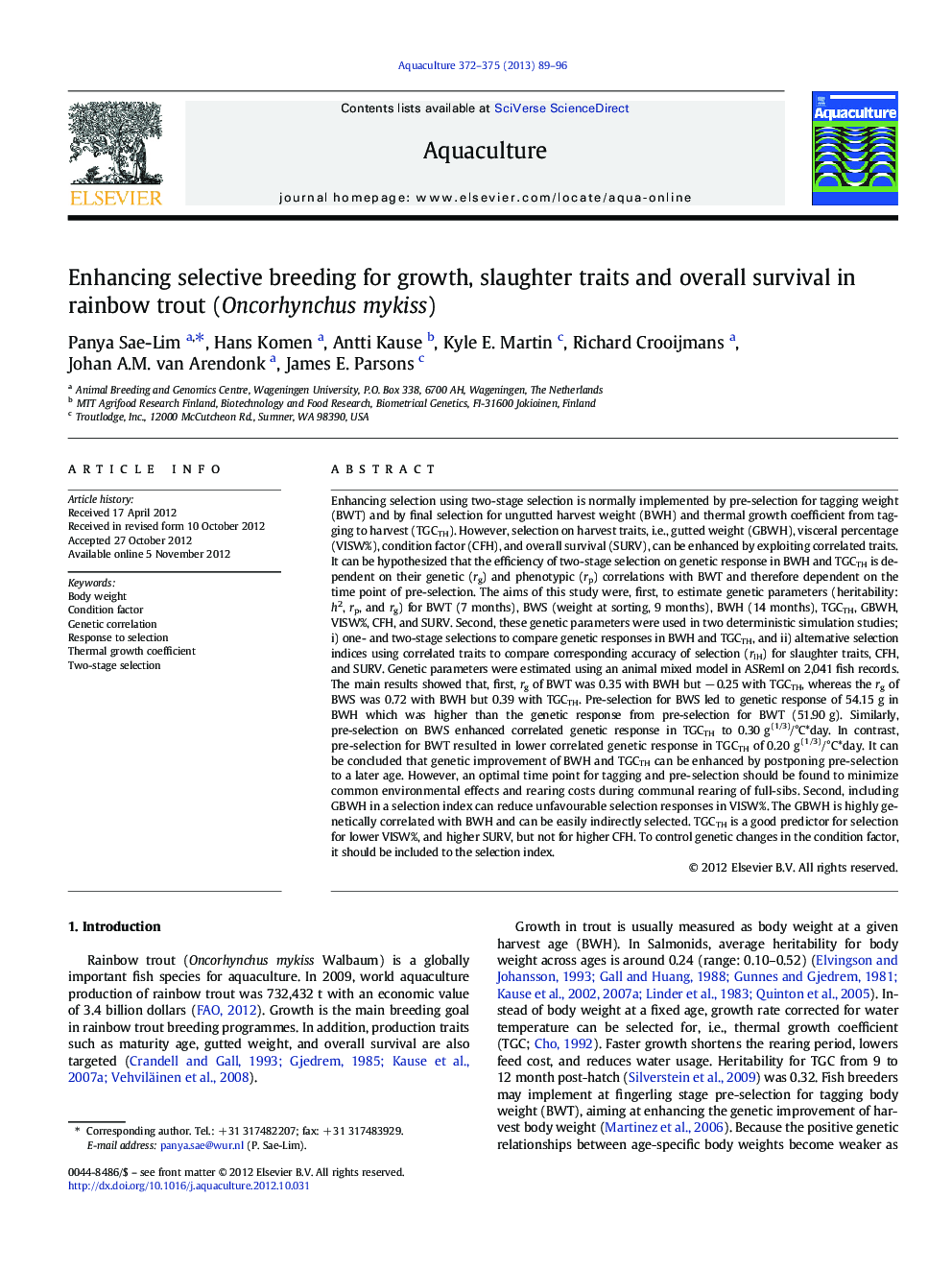| کد مقاله | کد نشریه | سال انتشار | مقاله انگلیسی | نسخه تمام متن |
|---|---|---|---|---|
| 2422275 | 1552880 | 2013 | 8 صفحه PDF | دانلود رایگان |

Enhancing selection using two-stage selection is normally implemented by pre-selection for tagging weight (BWT) and by final selection for ungutted harvest weight (BWH) and thermal growth coefficient from tagging to harvest (TGCTH). However, selection on harvest traits, i.e., gutted weight (GBWH), visceral percentage (VISW%), condition factor (CFH), and overall survival (SURV), can be enhanced by exploiting correlated traits. It can be hypothesized that the efficiency of two-stage selection on genetic response in BWH and TGCTH is dependent on their genetic (rg) and phenotypic (rp) correlations with BWT and therefore dependent on the time point of pre-selection. The aims of this study were, first, to estimate genetic parameters (heritability: h2, rp, and rg) for BWT (7 months), BWS (weight at sorting, 9 months), BWH (14 months), TGCTH, GBWH, VISW%, CFH, and SURV. Second, these genetic parameters were used in two deterministic simulation studies; i) one- and two-stage selections to compare genetic responses in BWH and TGCTH, and ii) alternative selection indices using correlated traits to compare corresponding accuracy of selection (rIH) for slaughter traits, CFH, and SURV. Genetic parameters were estimated using an animal mixed model in ASReml on 2,041 fish records. The main results showed that, first, rg of BWT was 0.35 with BWH but − 0.25 with TGCTH, whereas the rg of BWS was 0.72 with BWH but 0.39 with TGCTH. Pre-selection for BWS led to genetic response of 54.15 g in BWH which was higher than the genetic response from pre-selection for BWT (51.90 g). Similarly, pre-selection on BWS enhanced correlated genetic response in TGCTH to 0.30 g(1/3)/°C*day. In contrast, pre-selection for BWT resulted in lower correlated genetic response in TGCTH of 0.20 g(1/3)/°C*day. It can be concluded that genetic improvement of BWH and TGCTH can be enhanced by postponing pre-selection to a later age. However, an optimal time point for tagging and pre-selection should be found to minimize common environmental effects and rearing costs during communal rearing of full-sibs. Second, including GBWH in a selection index can reduce unfavourable selection responses in VISW%. The GBWH is highly genetically correlated with BWH and can be easily indirectly selected. TGCTH is a good predictor for selection for lower VISW%, and higher SURV, but not for higher CFH. To control genetic changes in the condition factor, it should be included to the selection index.
► We show how selection for growth, slaughter and survival traits can be enhanced.
► Pre-selection for early body weight increases genetic gain in harvest weight.
► Pre-selection for early body weight may not result in faster growing fish.
► Selection on gutted, not ungutted weight, is preferred when improving visceral%.
► Combined selection for body weight and growth rate enhances selection for survival.
Journal: Aquaculture - Volumes 372–375, 24 January 2013, Pages 89–96